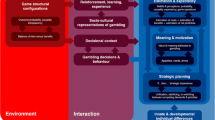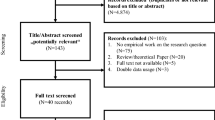Abstract
Few studies have investigated how gamblers perceive risk or the role of risk perception in disordered gambling. The purpose of the current study therefore was to obtain data on lay gamblers’ beliefs on these variables and their effects on decision-making, behaviour, and disordered gambling aetiology. Fifteen regular lay gamblers (non-problem/low risk, moderate risk and problem gamblers) completed a semi-structured interview following mental models and grounded theory methodologies. Gambler interview data was compared to an expert ‘map’ of risk-perception, to identify comparative gaps or differences associated with harmful or safe gambling. Systematic overlapping processes of data gathering and analysis were used to iteratively extend, saturate, test for exception, and verify concepts and themes emerging from the data. The preliminary findings suggested that gambler accounts supported the presence of expert conceptual constructs, and to some degree the role of risk perception in protecting against or increasing vulnerability to harm and disordered gambling. Gambler accounts of causality, meaning, motivation, and strategy were highly idiosyncratic, and often contained content inconsistent with measures of disordered gambling. Disordered gambling appears heavily influenced by relative underestimation of risk and overvaluation of gambling, based on explicit and implicit analysis, and deliberate, innate, contextual, and learned processing evaluations and biases.
Similar content being viewed by others
References
Aarons, G. A., Brown, S. A., Stice, E., & Coe, M. T. (2001). Psychometric evaluation of the marijuana and stimulant effect expectancy questionnaires for adolescents. Addictive Behaviors, 26(2), 219–236.
Baron, R. M., & Kenny, D. A. (1986). The moderator–mediator variable distinction in social psychological research: Conceptual, strategic, and statistical considerations. Journal of Personality and Social Psychology, 51(6), 1173–1182.
Binde, P. (2009). Gambling motivation and involvement: A review of social science research. Ostersund: Swedish National Institute of Public Health.
Blaszczynski, A., & Nower, L. (2002). A pathways model of problem and pathological gambling. Addiction, 97(5), 487–499.
Bostrom, A., Fischhoff, B., & Morgan, M. (1992). Characterizing mental models of hazardous processes: A methodology and an application to radon. Journal of Social Issues, 48(4), 85–100.
Breakwell, G. M. (2007). The psychology of risk. New York: Cambridge University Press.
Burgess, S., Rhodes, P., & Wilson, V. (2013). Exploring the in-session reflective capacity of trainees: An interpersonal process recall study. Clinical Psychology. doi:10.1111/cp12014.
Chiovitti, R. F., & Piran, N. (2003). Rigour and grounded theory research. Journal of Advanced Nursing, 44(4), 427–435.
Delfabbro, P. (2004). The stubborn logic of regular gamblers: Obstacles and dilemmas in cognitive gambling research. Journal of Gambling Studies, 20(1), 1–21.
Delfabbro, P. H., & Winefield, A. H. (1999). Poker machine gambling: An analysis of within session characteristics. British Journal of Psychology, 90, 425–439.
Derevensky, J., Sklar, A., Gupta, R., & Messerlian, C. (2010). An empirical study examining the impact of gambling advertisements on adolescent gambling attitudes and behaviors. International Journal of Mental Health and Addiction, 8(1), 21–34.
Ferris, J., & Wynne, H. (2001). The Canadian problem gambling index: Final report. Ottawa: Canadian Centre on Substance Abuse.
Fortune, E. E., & Goodie, A. S. (2011). Cognitive distortions as a component and treatment focus of pathological gambling: A review. Psychology of Addictive Behaviors, 26(2), 298–310.
Gillespie, M. A., Derevensky, J., & Gupta, R. (2007). The utility of outcome expectancies in the prediction of adolescent gambling behaviour. Journal of Gambling Issues, 19, 69–86.
Goldstein, R. Z., Craig, A., Bechara, A., Garavan, H., Childress, A. R., & Paulus, M. P. (2009). The neurocircuitry of impaired insight in drug addiction. Trends in Cognitive Sciences, 13(9), 372–380.
Grant, J. E., Schreiber, L., Odlaug, B. L., & Kim, S. W. (2010). Pathological gambling and bankruptcy. Comprehensive Psychiatry, 51(2), 115–120.
Harrigan, K., Dixon, M., MacLaren, V., Collins, K., & Fugelsang, J. (2011). The maximum rewards at the minimum price: Reinforcement rates and payback percentages in multi-line slot machines. Journal of Gambling Issues, 26(3), 11–29.
Hodgins, D. C. (2001). Processes of changing gambling behavior. Addictive Behaviors, 26, 121–128.
Holtgraves, T. (2009). Evaluating the problem gambler severity index. Journal of Gambling Studies, 25, 105–120.
Inglin, S., & Gmel, G. (2011). Beliefs about and attitudes toward gambling in French-speaking Switzerland. Journal of Gambling Studies, 27(2), 299–316.
Johansson, A., Grant, J. E., Kim, S. W., Odlaug, B. L., & Gotestam, K. (2009). Risk factors for problematic gambling: A critical literature review. Journal of Gambling Studies, 25(1), 67–92.
Jones, B. T., Corbin, W., & Fromme, K. (2001). A review of expectancy theory and alcohol consumption. Addiction, 96(1), 57–72.
LaPlante, D. A., Nelson, S. E., LaBrie, R. A., & Shaffer, H. J. (2008). Stability and progression of disordered gambling: Lessons from longitudinal studies. Canadian Journal of Psychiatry, 53(1), 52–60.
Leigh, B. C. (1999). Peril, chance, adventure: Concepts of risk, alcohol use and risky behavior in young adults. Addiction, 94(3), 371–383.
Milosevic, A., & Ledgerwood, D. M. (2010). The subtyping of pathological gambling: A comprehensive review. Clinical Psychology Review. doi:10.1016/j.cpr.2010.06.013.
Mischel, W. (2004). Toward an integrative science of the person. Annual Review of Psychology, 55, 1–22.
Moodie, C. (2007). An exploratory investigation into the erroneous cognitions of pathological and social fruit machine gamblers. Journal of Gambling Issues, 19, 31–49.
Morgan, M. G., Fischhoff, B., Bostrom, A., & Atman, C. J. (2002). Risk communication: A mental models approach. New York: Cambridge University Press.
Moscrop, A. (2011). Medicalisation, morality, and addiction: Why we should be wary of problem gamblers in primary care. British Journal of General Practice, 61(593), 836–838.
Rachlin, H. (1990). Why do people gamble and keep gambling despite heavy losses? Psychological Science, 1(5), 294–297.
Raylu, N., & Oei, T. P. S. (2002). Pathological gambling: A comprehensive review. Clinical Psychology Review, 22(7), 1009–1061.
Richards, L. (2005). Handling qualitative data: A practical guide. London: Sage Publications.
Rinn, W., Desai, N., Rosenblatt, H., & Gastfriend, D. R. (2002). Addiction denial and cognitive dysfunction: A preliminary investigation. The Journal of Neuropsychiatry and Clinical Neurosciences, 14(1), 52–57.
Smith, G. T., Goldman, M. S., Greenbaum, P. E., & Christiansen, B. A. (1995). Expectancy for social facilitation from drinking: The divergent paths of high-expectancy and low-expectancy adolescents. Journal of Abnormal Psychology, 104(1), 32–40.
Spurrier, M., & Blaszczynski, A. (2013). Risk perception in gambling: A systematic review. Journal of Gambling Studies. doi:10.1007/s10899-013-9371-z.
Spurrier, M., Blaszczynski, A., & Rhodes, P. (Submitted). An expert map of gambling risk perception. Journal of Gambling Studies.
Strauss, A., & Corbin, J. (1994). Grounded theory methodology: An overview. Thousand Oaks: Sage Publications.
Strauss, A., & Corbin, J. (1998). Basics of qualitative research: Techniques and procedures for developing grounded theory (2nd ed.). Thousand Oaks: Sage Publications.
Toneatto, T. (1999). Cognitive psychopathology of problem gambling. Substance Use and Misuse, 34(11), 1593–1604.
Weinstein, N. D. (2007). Misleading tests of health behavior theories. Annals of Behavioral Medicine, 33(1), 1–10.
Wickwire, E. M., Whelan, J. P., & Meyers, A. W. (2010). Outcome expectancies and gambling behavior among urban adolescents. Psychology of Addictive Behaviors, 24(1), 75–88.
Wickwire, E. M., Whelan, J. P., West, R., Meyers, A., McCausland, C., & Luellen, J. (2007). Perceived availability, risks, and benefits of gambling among college students. Journal of Gambling Studies, 23(4), 395–408.
Wong, S., & Tsang, S. (2012). Development and validation of the Chinese adolescent gambling expectancy scale. International Gambling Studies, 12(3), 309–329.
Yi, S., & Kanetkar, V. (2010). Implicit measures of attitudes toward gambling: An exploratory study. Journal of Gambling Issues, 24, 140–163.
Conflict of interest
The authors declare that they have no conflict of interest.
Author information
Authors and Affiliations
Corresponding author
Rights and permissions
About this article
Cite this article
Spurrier, M., Blaszczynski, A. & Rhodes, P. Gambler Risk Perception: A Mental Model and Grounded Theory Analysis. J Gambl Stud 31, 887–906 (2015). https://doi.org/10.1007/s10899-013-9439-9
Published:
Issue Date:
DOI: https://doi.org/10.1007/s10899-013-9439-9




